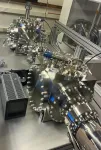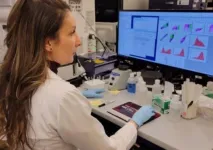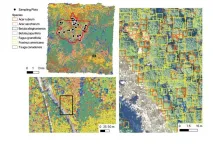(Press-News.org) Each cell in the body has its own unique delivery system that scientists are working on harnessing to move revolutionary biological drugs — molecules like proteins, RNA and combinations of the two — to specific diseased parts of the body.
A new study from Northwestern University hijacked the transit system and sent tiny, virus-sized containers to effectively deliver an engineered protein to its target cell and trigger a change in the cell’s gene expression. The success came from encouraging engineered proteins to move toward a specific cell membrane structure that the researchers found increased a protein’s likelihood of latching onto the container.
Published in July in the journal Nature Communications, the paper contends the novel technique could be generalizable, paving the road for the goal of targeted biological drug delivery.
The study brings researchers a step closer to addressing a major bottleneck for biological medicine development, determining how to protect fragile molecules in the body and ensure they reach the correct diseased cells in a patient without impacting healthy cells.
The research combines work from two labs in Northwestern’s Center for Synthetic Biology: those of biomedical engineer Neha Kamat and chemical and biological engineer Josh Leonard. The Kamat lab has largely focused on the design of synthetic containers and uses biophysical principles to control molecules targeting other cells. Leonard’s lab develops tools to build these natural delivery containers, termed extracellular vesicles (EVs).
“We were interested in applying some of the biophysical insights that have emerged about how to localize proteins to specific membrane structures so that we could hijack this natural system,” said Kamat, the paper’s co-corresponding author and associate professor at the McCormick School of Engineering. “In this study, we discover general ways to load drug cargo into these vesicles very efficiently while preserving their function. This might enable more effective and affordable extracellular vesicle-based biological medicines.”
The keys to this “cargo loading” approach are sites on cell membranes called lipid rafts. These regions are more structured than the rest of the membrane and reliably contain specific proteins and lipids.
“Lipid rafts are thought by some to play a role in the genesis of EVs, as EV membranes contain the same lipids found in lipid rafts,” said Justin Peruzzi, who co-led the study with Taylor Gunnels as doctoral students in Kamat’s lab. Gunnels’ work in the lab is ongoing, and Peruzzi, who completed his Ph.D., works as a scientist at a protein-based medicine company. “We hypothesized that if we engineered proteins to associate with lipid rafts, they may be loaded into the vesicles, allowing them to be delivered to other cells.”
The team used protein databases and lab experiments to determine that lipid raft-association is an efficient method to load protein cargo into EVs, enabling up to a stunning 240 times more protein to be loaded into vesicles.
After discovering this biophysical principle, the researchers demonstrated a practical application of the method. They engineered cells to produce a protein called a transcription factor, loaded it into EVs and then delivered it to a cell to alter the recipient cell’s gene expression — without compromising the protein’s function upon delivery.
Kamat and Leonard said the main challenge in loading therapeutic cargo into EVs is that the producer cell and the recipient cell are often at odds with each other. In the cell producing the EV, for example, you might engineer therapeutic cargo to associate tightly to a membrane to increase the chance it moves into a soon-to-be released EV. However, this same behavior is often undesirable in a recipient cell because delivered cargo stuck to a membrane might be nonfunctional. Instead, you might want that cargo to release from the EV membrane and move to the cell’s nucleus to perform its biological function. The answer was the creation of cargo with reversible functions.
“Tools that enable reversible membrane association could be really powerful when building EV-based medicines,” said Gunnels. “Although we’re not yet sure of the precise mechanism, we see evidence of this reversibility with our approach. We were able to show that by modulating lipid-protein interactions, we could load and functionally deliver our model therapeutic cargo. Looking forward, we’re eager to use this approach to load therapeutically relevant molecules, like CRISPR gene-editing systems.”
The researchers said they’re eager to try the approach with medicinal cargo for disease applications in immunotherapy and regenerative medicine.
“If we can load functional biomedicines into EVs that are engineered to only deliver those biomolecules to diseased cells, we can open the door to treating all sorts of diseases,” said Leonard, the co-corresponding author and a McCormick professor. “Because of the generalizability that we observed in our system, we think this study's findings could be applied to deliver a wide array of therapeutic cargos for various disease states.”
The paper, titled “Enhancing extracellular vesicle cargo loading and functional delivery by engineering protein-lipid interactions,” was supported by the McCormick Research Catalyst Program at Northwestern University, the National Science Foundation (grants 1844219 and 2145050) and NSF Graduate Research Fellowships (DGE-1842165).
END
Transporting precious cargo using the body’s own delivery system
Advances ‘get us one step closer to the ultimate goal of targeted biological drug delivery’
2024-07-16
ELSE PRESS RELEASES FROM THIS DATE:
SwRI, UTD jointly fund project to evaluate space sensor in unique facility
2024-07-16
SAN ANTONIO — July 16, 2024 — Researchers from Southwest Research Institute (SwRI) and The University of Texas at Dallas (UTD) are collaborating to evaluate a next-generation sensor designed to measure neutral gas velocities in the Earth’s upper atmosphere. The project, led by SwRI’s Dr. Joo Hwang and UTD’s Dr. Phillip Anderson, is supported by a grant from the new SwRI/UTD Seed Projects for Research, INnovation, and Technology (SPRINT) Program. Another SPRINT project is researching domestic lithium independence, looking at ...
Nature-based solutions to disaster risk from climate change are cost effective, UMmass Amherst study confirms
2024-07-16
AMHERST, Mass. – A new global assessment of scientific literature led by researchers at the University of Massachusetts Amherst finds that nature-based solutions (NbS) are an economically effective method to mitigate risks from a range of disasters—from floods and hurricanes to heatwaves and landslides—which are only expected to intensify as Earth continues to warm.
NbS are interventions where an ecosystem is either preserved, sustainably managed or restored to provide benefits to society and to nature. For instance, they can mitigate risk from a natural disaster, or facilitate climate mitigation and adaptation. NbS ...
Decline in global adolescent fertility rates is counteracted by increasing teen births in Sub-Saharan Africa
2024-07-16
July 16, 2024-- A new report from Columbia University Mailman School of Public Health and the Columbia Aging Center with colleagues from the Norwegian Institute of Public Health highlights a troubling trend: while global adolescent fertility rates have significantly declined, sub-Saharan Africa is experiencing an increase in teen births. This region's share of global adolescent births surged from 12 percent in 1950 to 47 percent in 2020 and is projected to reach a clear majority – a full 67 percent - by ...
Apps and AI could help personalize depression diagnosis and treatment
2024-07-16
New research at the University of Illinois Chicago is testing whether digital tools can help predict which patients with depression will benefit from specific treatments and help deliver those treatments to them on demand.
Two new grants awarding over $10 million to UIC will help Dr. Jun Ma and colleagues in the College of Medicine investigate the use of a smartphone app, an AI voice assistant and other technologies to diagnose and treat depression.
The researchers hope these tools will both broaden access to psychiatric care and ...
Researchers create new template of the human brain
2024-07-16
The human brain is responsible for critical functions, including perception, memory, language, thinking, consciousness, and emotions.
To understand how the brain works, scientists often use neuroimaging to record participants’ brain activity when the brain is performing a task or at rest. Brain functions are systematically organized on the cerebral cortex, the outer layer of the human brain. Researchers often use what is called a "cortical surface model" to analyze neuroimaging data and study the functional organization of the ...
Study identifies protein that helps COVID-19 virus evade immune system
2024-07-16
An article published in the journal Cell describes a study that enabled a group of researchers to discover how SARS-CoV-2 evades the cytotoxic immune response by identifying a protein called ORF6 that is a key factor in this mechanism.
The cytotoxic immune response involves T-lymphocytes that kill pathogens when they recognize cells bearing a specific antigen while sparing neighboring uninfected cells.
The study was led by Wilfredo Garcia-Beltran and Julie Boucau, research scientists at the Ragon ...
Scientists use machine learning to predict diversity of tree species in forests
2024-07-16
A collaborative team of researchers led by Ben Weinstein of the University of Florida, Oregon, US, used machine learning to generate highly detailed maps of over 100 million individual trees from 24 sites across the U.S., publishing their findings July 16th in the open-access journal PLOS Biology. These maps provide information about individual tree species and conditions, which can greatly aid conservation efforts and other ecological projects.
Ecologists have long collected data on tree species to better understand a forest’s unique ecosystem. Historically, this has been done by surveying small plots of land and extrapolating those findings, though this cannot account for ...
Machine learning helps define new subtypes of Parkinson’s disease
2024-07-16
Researchers at Weill Cornell Medicine have used machine learning to define three subtypes of Parkinson’s disease based on the pace at which the disease progresses. In addition to having the potential to become an important diagnostic and prognostic tool, these subtypes are marked by distinct driver genes. If validated, these markers could also suggest ways the subtypes can be targeted with new and existing drugs.
The research was published on July 10 in npj Digital Medicine.
“Parkinson’s disease is highly heterogeneous, which means that ...
Weight loss influences risky decisions in obesity
2024-07-16
People who are severely overweight (obese) not only exhibit altered risk behavior, but also changes in their metabolism and psyche. It was previously assumed that severely obese people are more impulsive and show an increased willingness to take a risk. Scientists from the DZD partner German Institute of Human Nutrition Potsdam-Rehbrücke (DIfE) have now investigated whether massive weight loss leads to an improvement in metabolic and psychological states and whether decision-making is improved. The results were published in the journal 'Clinical Nutrition'.
Being overweight can cause metabolism to slip
Our behavior depends on many factors. ...
EurekAlert! Travel Awards recognize early-career science journalists in Eastern Europe for the first time
2024-07-16
The winners of the 2024 EurekAlert! Travel Awards are Pavla Hubálková, a Czech science journalist at WIRED.CZ, and Iris Duțescu, a Romanian freelance science journalist.
An independent panel of three judges with regional science journalism expertise selected the winners. Both awardees will receive travel support from EurekAlert! to attend the 2025 Annual Meeting of the American Association for the Advancement of Science (AAAS) in Boston, Mass., where they will have opportunities to cover the latest scientific research and make connections with scientists ...
LAST 30 PRESS RELEASES:
Making lighter work of calculating fluid and heat flow
Normalizing blood sugar can halve heart attack risk
Lowering blood sugar cuts heart attack risk in people with prediabetes
Study links genetic variants to risk of blinding eye disease in premature infants
Non-opioid ‘pain sponge’ therapy halts cartilage degeneration and relieves chronic pain
AI can pick up cultural values by mimicking how kids learn
China’s ecological redlines offer fast track to 30 x 30 global conservation goal
Invisible indoor threats: emerging household contaminants and their growing risks to human health
Adding antibody treatment to chemo boosts outcomes for children with rare cancer
Germline pathogenic variants among women without a history of breast cancer
Tanning beds triple melanoma risk, potentially causing broad DNA damage
Unique bond identified as key to viral infection speed
Indoor tanning makes youthful skin much older on a genetic level
Mouse model sheds new light on the causes and potential solutions to human GI problems linked to muscular dystrophy
The Journal of Nuclear Medicine ahead-of-print tip sheet: December 12, 2025
Smarter tools for peering into the microscopic world
Applications open for funding to conduct research in the Kinsey Institute archives
Global measure underestimates the severity of food insecurity
Child survivors of critical illness are missing out on timely follow up care
Risk-based vs annual breast cancer screening / the WISDOM randomized clinical trial
University of Toronto launches Electric Vehicle Innovation Ontario to accelerate advanced EV technologies and build Canada’s innovation advantage
Early relapse predicts poor outcomes in aggressive blood cancer
American College of Lifestyle Medicine applauds two CMS models aligned with lifestyle medicine practice and reimbursement
Clinical trial finds cannabis use not a barrier to quitting nicotine vaping
Supplemental nutrition assistance program policies and food insecurity
Switching immune cells to “night mode” could limit damage after a heart attack, study suggests
URI-based Global RIghts Project report spotlights continued troubling trends in worldwide inhumane treatment
Neutrophils are less aggressive at night, explaining why nighttime heart attacks cause less damage than daytime events
Menopausal hormone therapy may not pose breast cancer risk for women with BRCA mutations
Mobile health tool may improve quality of life for adolescent and young adult breast cancer survivors
[Press-News.org] Transporting precious cargo using the body’s own delivery systemAdvances ‘get us one step closer to the ultimate goal of targeted biological drug delivery’




